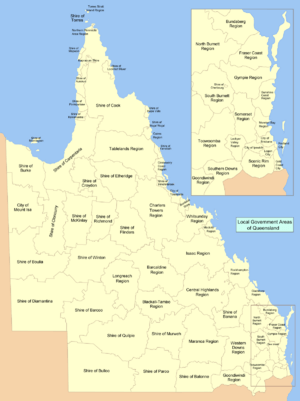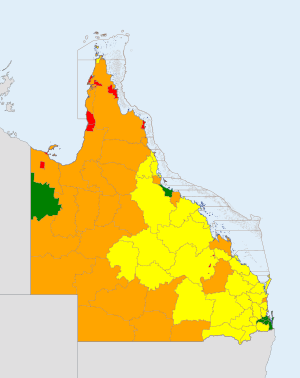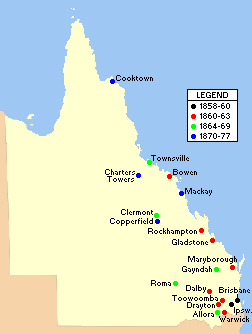Local government in Queensland facts for kids
Local government in Queensland is how towns and districts in this Australian state manage their own local matters. This is allowed by a special law called the Local Government Act. Queensland is split into 77 different areas, which are called Cities, Towns, Shires, or Regions.
Each area has a council. This council is like a local government team. They are in charge of providing many public services and things people use every day. These include things like roads, parks, libraries, and rubbish collection. Councils get their money from local taxes (called rates) that people pay on their properties. They also get money from the State and Federal governments.
Local councils get their power from the Queensland Parliament. This means the State government can create, join, split, or even remove councils if needed. However, these big decisions are usually made based on advice from special groups like the Local Government Reform Commission. For example, in 2008, many local government areas in Queensland were joined together into bigger ones. This caused a lot of discussion at the time.
Because of these changes, the four largest local government areas in Australia by population in 2011 were all in Queensland:
| Rank | Local government area | Population (2011 census) |
|---|---|---|
| 1 | City of Brisbane | 1,041,841 |
| 2 | City of Gold Coast | 494,503 |
| 3 | Moreton Bay Region | 378,047 |
| 4 | Sunshine Coast Region | 306,909 |
Contents
History of Local Government
Early Beginnings
The idea of local government in Queensland started even before Queensland became a separate colony from New South Wales. In 1858, a law called the Municipalities Act allowed communities to form their own local governments. If enough householders (people living in homes) in an area asked for it, a municipality could be created.
The very first municipality was Brisbane in 1859. Soon after, Ipswich also became a municipal town in 1860. After that, other towns like Toowoomba, Rockhampton, and Maryborough also formed their own local councils. By 1879, most of Queensland had some form of local administration.
New Laws and Changes
In 1864, Queensland passed its first big law for local government, the Municipal Institutions Act. This law gave municipalities more power. They could now collect taxes (rates), borrow money, make local rules (bylaws), and manage public services like roads, water, and parks.
Under this new law, creating a new municipality became clearer. People who paid rates could vote in elections. They could have between one and three votes depending on how much tax they paid. Councils were elected every year, and they chose a mayor from their members. Municipalities could also be divided into smaller sections called wards.
Later, in 1878, the Local Government Act was passed. It said that municipal councils were there to keep "good rule and government" and provide public services. These services included parks, libraries, cemeteries, roads, and public health. This law allowed for new municipalities to be called Cities, Boroughs, or Shires. Both men and women over 21 who paid rates could vote.
At the same time, the Divisional Boards Act 1879 was introduced. This law helped bring local government to the large, less populated areas of Queensland that weren't part of municipalities. It divided these areas into 74 "divisions," each with its own board.
The Twentieth Century
With the Local Authorities Act 1902, the old municipalities became Towns (unless they were already Cities), and the divisions became Shires. This happened on 31 March 1903. This law also gave councils more power over their areas.
In 1920, a new law changed local government elections. Now, all adults could vote, not just those who paid rates. Elections were held every three years instead of every year. Mayors and shire chairmen were also elected directly by the public, not by the council members themselves.
By the time the Local Government Act 1936 came into effect, the different names like City, Town, or Shire didn't really mean different powers. They were mostly just names. A place became a City if it met certain rules and the Governor announced it.
In 1925, many local governments around Brisbane were joined together to create the City of Brisbane. Its council, the Brisbane City Council, became a very powerful "super-council" with some powers usually held by the state. It even has its own special law, the City of Brisbane Act 1924. Today, it has over 1 million people. However, many people who live in the greater Brisbane area actually live in nearby cities like Ipswich and Logan, which are managed under the general Local Government Act.
In 1989, a group called the Electoral and Administrative Reform Commission looked into how Queensland's public services were run. One of their jobs was to review the local government laws and boundaries. As a result of their ideas, several councils were joined together, and a new Local Government Act 1993 was introduced.
Indigenous Councils
In the mid-1980s, special laws were passed for Aboriginal and Torres Strait Islander communities. Many former reserves and missions, especially in the Cape York region and some Torres Strait islands, were given to these communities to manage. Special groups called Indigenous community councils were set up to look after this land. These councils had different jobs than regular local governments because of how the land was owned.
Later, between 2005 and 2007, these groups became "Aboriginal Shire Councils" and "Island Councils." They gained more powers, similar to other local governments. In 2008, some of them were joined into larger areas like the Torres Strait Island Region or the Northern Peninsula Area Region.
The Twenty-First Century
Local Government Reform Commission
In 2007, the Queensland Government set up a group called the Local Government Reform Commission. This independent group was asked to suggest the best way to organize local governments in Queensland. They looked at every local government, except for Brisbane City Council because it was already very large.
The main reason for this review was that many smaller councils, especially in rural areas, were struggling financially. They didn't have enough people or money to keep going easily.
The Commission suggested big changes in July 2007. They recommended joining many councils across the state into larger "regions." These new regions would be managed by regional councils and would be based around major towns. The idea was to make councils more efficient and financially stable. For example, the Sunshine Coast area, which had three councils, was to become one. The cities of Townsville and Thuringowa in North Queensland were also merged.
The Commission found that about 40% of councils were in a "financially weak" or "distressed" state. This meant they had trouble paying for services and managing their money. To fix this, the independent Commission was created to recommend new boundaries and structures.
These changes caused a lot of debate and protests in many areas. Some councils even tried to hold their own votes against the mergers. However, on 10 August 2007, the Commission's recommendations became law. New "Local Transition Committees" were set up to help with the changes. On 15 March 2008, the old councils officially ended, and elections were held for the new, larger councils.
Commission Members
The Commission was made up of seven members, including former government officials and experts in local government and finance.
Outcomes
The Queensland Parliament passed the Local Government (Reform Implementation) Act 2007 on 10 August 2007. This law put the Commission's recommendations into action. On 15 March 2008, local government elections were held, and the new, larger local government areas began operating across Queensland.
De-amalgamation
Even after the new councils were created in 2008, many people still didn't like the mergers. During the 2012 state election, the Liberal National Party promised to look at the mergers again if they won. When they came into power, they invited former shires that wanted to split back apart to make a case for it.
To split, a former shire had to show:
- It could manage its money well if it became separate again.
- It would pay all the costs of splitting.
- At least 20% of its voters supported the idea.
If these conditions were met, people in the former shire would vote on it. Submissions were received from 19 communities, but only four were approved for a vote: Douglas, Livingstone, Mareeba, and Noosa.
On 9 March 2013, citizens in these four areas voted to split. In all four cases, most people voted in favor of splitting. As a result, the Queensland Government passed a new law in April 2013 to make these splits happen.
- The Shire of Douglas separated from the Cairns Region.
- The Shire of Livingstone separated from the Rockhampton Region.
- The Shire of Mareeba separated from the Tablelands Region.
- The Shire of Noosa separated from the Sunshine Coast Region.
These changes officially took effect on 1 January 2014.




